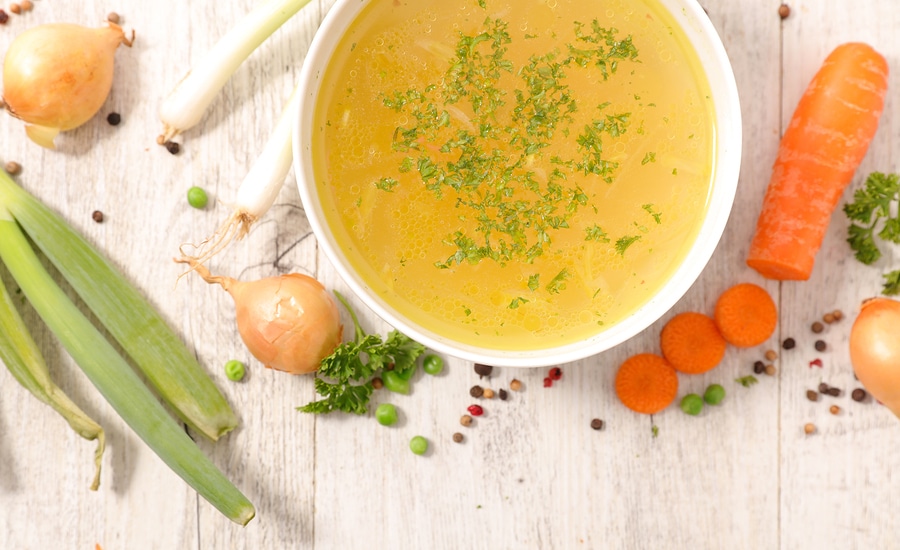
This is hands-down the best homemade chicken stock recipe I’ve ever had.
This is my mom’s chicken stock recipe. She used to make it almost every weekend in the cold months when I was growing up. I’ve tried variations but I always come back to this tried-and-true version.
There’s a reason chicken stock is the base of so many soups and sauces—it has a delicious savory flavor and is incredibly nutritious. It’s used frequently in healthy soup recipes, gravy, and pan sauces for dishes like Chicken Picatta.
Just like homemade veggie stock from scratch and other stock recipes, you can genuinely tell the difference between homemade and store-bought chicken stock.
I’m giving you a lot of details here so you can use what you have on hand and make different variations of homemade stock, so you can jump to a specific section if you need it:
Basic Chicken Stock from Scratch
The basic recipe for chicken stock from scratch is simply simmering chicken bones in a pot with water, vegetables, and aromatics—aka the carrot, celery, onion, herbs, whole peppercorns, and spices that help to flavor your stock.
The stock will develop part of its nutrition profile from the veggies and aromatics, but the most significant healing factor in stock is the minerals, collagen, and gelatin extracted from the chicken bones while they simmer.
Adding some vinegar, lemon, or something acidic to your stock recipe helps extract the good stuff out of the bones. If you simmer it long enough, you’re essentially making homemade bone broth.
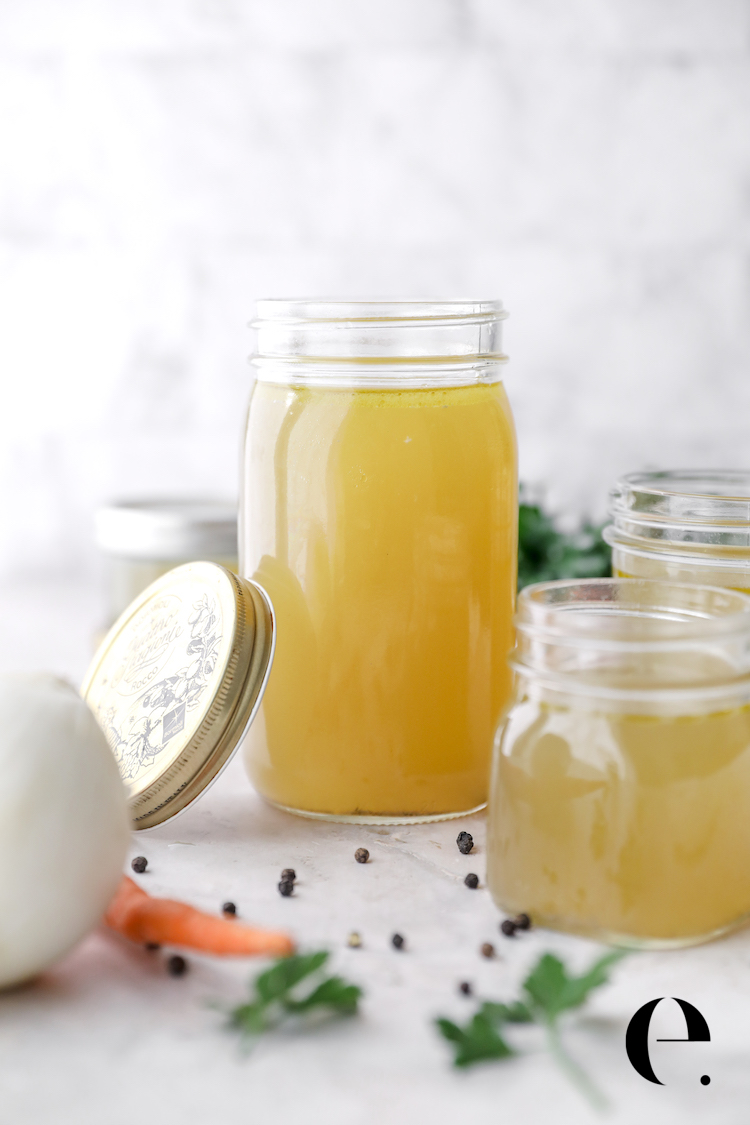
Use a Whole Chicken or Chicken Parts
There are a few options for the chicken base of your stock.
- A whole raw chicken: The chicken stock recipe in the printable recipe carb below uses a whole chicken. You can use the leftover meat in another dish, like chicken noodle soup, chicken salad, or chicken lettuce wraps.
- Chicken carcass from roasting a whole bird: You can make this recipe with any leftover bones or the whole chicken carcass after you roast a whole chicken (or turkey for turkey stock). When you roast a chicken or turkey, remove all of the meat, then use the leftover bones & skin (the entire carcass) in your stock.
- Individual pieces: If you roast individual bone-in chicken pieces like bone-in chicken breasts, whole legs, wings and/or thighs, use the meat and put all of the bones and skin leftover into the pot with your vegetables and aromatics.
This chicken stock recipe is beyond simple, even for first-timers! The prep time is minimal and your chicken stock can just simmer away while you prepare other food or go on with your day (or even while you sleep).
Vegetables in Chicken Stock
The main veggies in traditional chicken stock are:
- white or yellow onion
- carrots
- celery
The main aromatics are:
- whole peppercorns
- bay leaf
- herbs like thyme, parsley and/or dill
Other additions can include fennel bulb, whole garlic cloves, and mushroom stems to enrich your broth.
Fennel will add an anise flavor to your stock so only use that if you love the taste of fennel. Garlic can be a nice addition to your stock, just be mindful that whatever you use your stock for will have a garlicky flavor. Mushroom stems leftover from mushrooms in another recipe will add a nice umami richness to your stock.
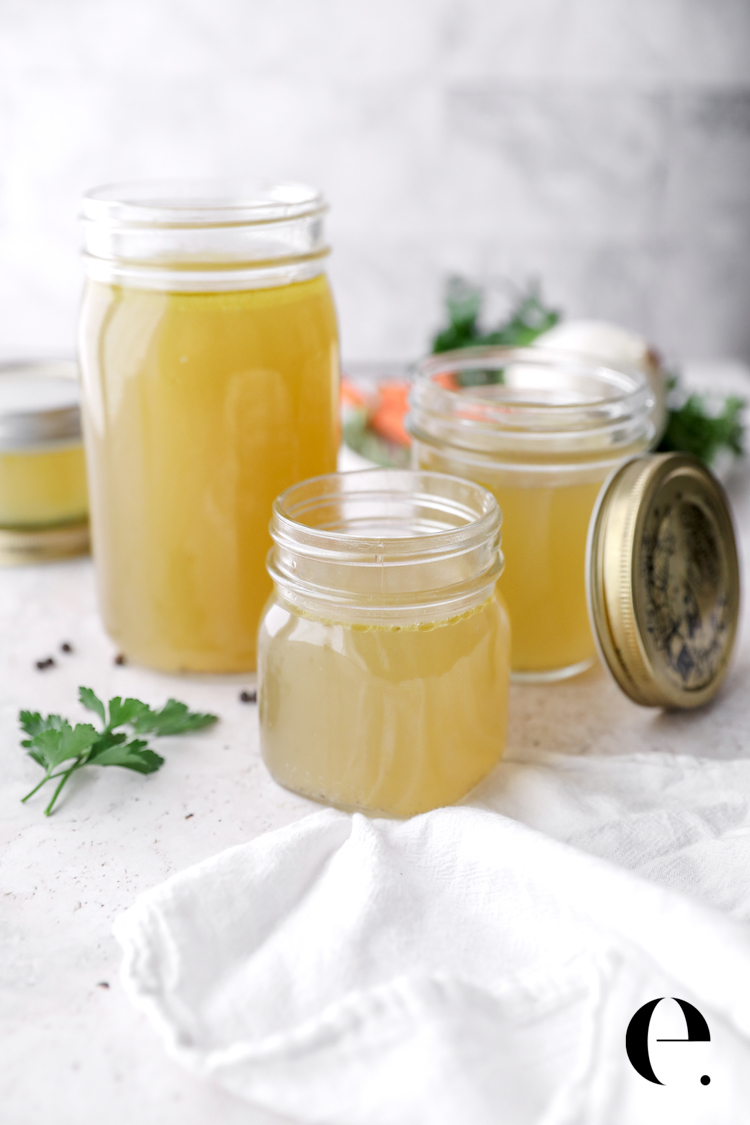
The Difference Between Stock, Broth, & Bone Broth
Are chicken broth and chicken stock the same thing? Yes, pretty much. Chicken broth and chicken stock are essentially the same things. If you ask 10 chefs what the difference between stock and broth is, you’ll probably get 10 different answers.
For the sake of this post, I’m going to say that stock and broth are the same thing.
Just like stock and broth, there isn’t a strict definition between regular broth and bone broth. The most significant difference is probably the vinegar and the amount of time that you let it simmer.
You can make a wonderful stock in as little as 4-6 hours which is great for your health. To get the maximum benefit and flavor from the bones, simmer for at least 12-24 hours.
If you want to turn your chicken stock recipe into traditional bone broth, you should add as many extra bones as possible. Ask your butcher for any leftover bones (even chicken feet!) that they have behind the counter. Add a tablespoon of vinegar, then simmer for 12-24 hours.
How to Make Chicken Stock
The printable version of this recipe is below.
Step 1: Get a Whole Chicken (or Chicken Parts)
I like to ask the butcher counter to remove the bag of organs for me since you don’t need that for your stock. Some people use it and that’s fine, but the organs can change the flavor so I don’t use them in this dish.
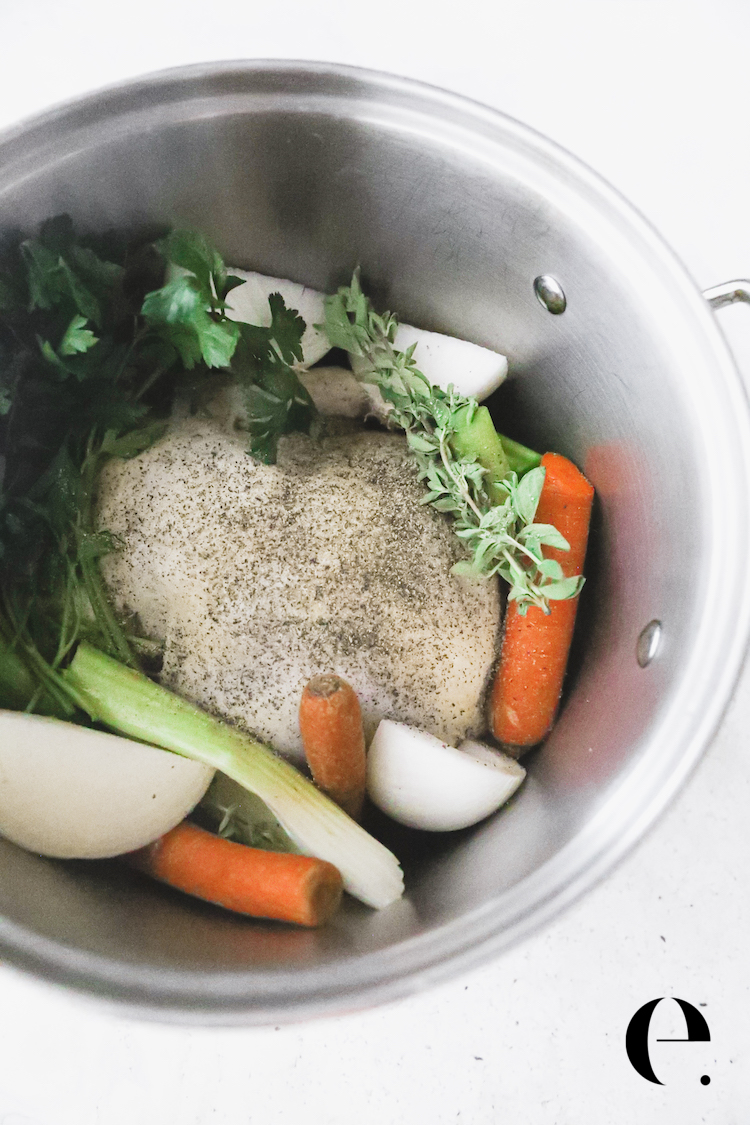
Step 2: Fill the Pot
In the largest pot you have (preferably at least 6 quarts), place the whole chicken (make sure there isn’t any paper in the cavity), the veggies and aromatics in the pot, then cover with water being sure to leave a few inches above the water so it doesn’t boil over.
It will look something like this when you put it on the stove to come up to a simmer:
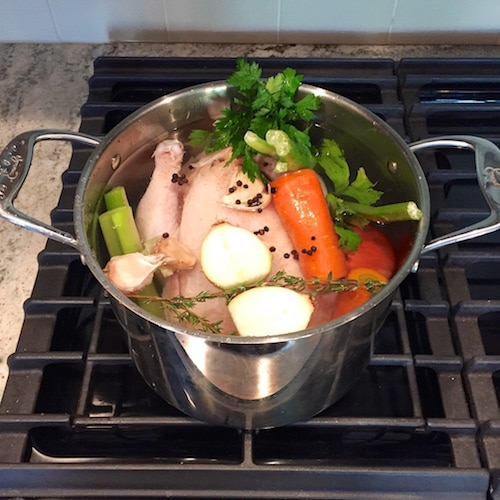
Again, you could also make this recipe using just the chicken bones (with the meat removed) after roasting a whole chicken or pieces of chicken.
If you ever roast a whole chicken or turkey, simply use whatever is left from the whole chicken after removing the meat (bones, skin, and juices all make great additions to your stock)!
3. Bring to a Boil, Reduce to Simmer
Set it on the stove, bring to a boil, then reduce the heat to a simmer. Allow it to simmer for at least 4 and up to 24 hours.
*If you use a whole chicken, remove the meat from the chicken after about 2 hours (once it’s cooked through) to prevent overcooking it. After you remove the meat—be sure to get all of the breast meat, leg meat, and thigh meat—put everything back in the pot to continue cooking the stock.
To remove the meat from the whole chicken, follow these steps:
- Carefully remove the whole chicken from the pot and set it on a large cutting board. It will be very hot, so let it cool a bit before you handle it.
- Use two forks or a knife to remove as much of the cooked chicken meat as possible. The meat will be nicely poached. You can shred it or just cut it up.
- Put the meat in an airtight glass container. Let it come to room temperature before storing it in the refrigerator, where you can keep it for up to three days. You can also use it right away after your stock is done if making soup.
- BE SURE to place all of the bones, skin, juices, and everything else back into the pot after removing the meat to continue making chicken stock.
Let it simmer for at least another 2 hours, or up to 24 hours. The longer you simmer the stock, the more flavorful and nutritious it will be.
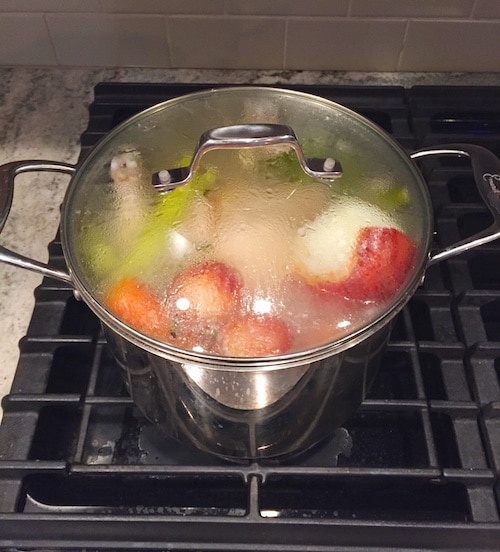
Step 4: Simmer 4-24 Hours, Then Strain
Keep the pot covered with a lid while it simmers to prevent your stock from evaporating. If you notice the liquid reducing too much, you can add a few cups of water at any time during the process.
After simmering for at least 4 hours in total, strain your stock through a fine-mesh strainer, colander, or cheesecloth into a large bowl or pot.
Discard everything that was in the pot except the liquid you just strained. The veggies, herbs, and bones are no longer usable for other recipes (they should be really soggy and cooked down—they’ve served their purpose!).
Chicken Stock in a CrockPot
CrockPot owners, rejoice! You can follow the above directions but use a slow-cooker (aka Crockpot) instead.
- Add all of the ingredients and water to your CrockPot.
- Turn the heat to high until it comes to a simmer—probably about 2 hours. It will take a while to simmer, as the slow-cooker heats at a slower pace than your stovetop.
- Remove the meat once it’s cooked through, roughly 2.5-3.5 hours in. (Skip this if using chicken parts or a chicken carcass.)
- Add everything back in just like the method above. Let it all simmer on LOW for 4-24 hours.
- Keep it covered and let it simmer as long as you’d like. You may want to add another cup or two of filtered water if too much liquid evaporates.
All slow-cookers are different. You may want to leave it on high if it’s not gently simmering on low. I leave mine on low overnight after being set on high for about 3 hours and put it on low evernight.
To store, let it come to room temperature. Then store in quart containers in the refrigerator for up to 3 days or in the freezer for up to 6 months.
If freezing, freeze in portions that will be useful to use in recipes, like 2-cup (1-pint) or 4-cup (1-quart) containers.
Chicken Stock in an InstantPot
Yes, you can make chicken stock in a pressure cooker like an InstantPot. To do it:
- Place all of the ingredients in your instant pot and fill with enough water to just cover everything, being sure not to fill the pressure cooker more than about 2/3 full (a pressure cooker can’t come up to pressure if it’s too full). That means you may have to reduce the ingredients or cut the chicken parts in half if you had a big chicken.
- Set to pressure cook on high for 40 minutes.
- It will take about 20 minutes to come up to pressure, and do a natural release for 30 minutes. All in, it will take about 90-100 minutes to make chicken stock in a pressure cooker.

Best-Ever Chicken Stock Recipe
- Prep Time: 10 mins
- Cook Time: 4 hours
- Total Time: 5 hours 10 mins
- Yield: 4 quarts 1x
- Category: Soup, Healthy
- Method: Simmer
- Cuisine: American
Description
This chicken stock recipe was a staple in my home growing up. I remember my mom making chicken stock on the stove every weekend, all winter long. Use it as the base of soups, stews, gravies, or sauces, or sip it plain for a nourishing, savory treat.
Ingredients
- 1 whole chicken (3-5 pounds), any paper inside removed
- 1 white or yellow onion, quartered
- 2 large carrots, scrubbed or peeled and cut in half
- 2–3 celery ribs, with leaves if possible
- 3–4 garlic cloves, smashed open or cut in half
- 1 large bay leaf
- 3–5 sprigs fresh thyme
- 5 stems fresh parsley (about 1 small handful)
- 2 teaspoons sea salt
- 1/2 teaspoon whole black peppercorns
- 1 tablespoon apple cider vinegar
- enough filtered water to fill the pot
Instructions
- Place a 6- to 8-quart pot with a tight-fitting lid on the stovetop. I use a 6-quart pot for a 4- or 5-pound chicken.
- Remove the paper pouch that contains the organs if it’s still in the chicken. Use in another recipe or discard.
- Add all ingredients to the pot. Clean the veggies but it’s ok to leave the skin on the onion and carrots. Cover with filtered cold water to about an inch below the top.
- Put a tight-fitting lid on the pot.
- Set it on the stove and bring it to a boil. This takes about 10-20 minutes.
- Immediately reduce to a simmer. Simmer for at least 4 hours or up to 24 hours. The longer the simmer, the better the flavor.
- If you use a whole chicken, remove the meat from the chicken after 2 hours to prevent overcooking it. (See the sections above for my method to remove the meat).
- Keep the pot covered to prevent your stock from evaporating. If you notice the liquid reducing too much, you can add a few cups of water at any time during the process.
- After simmering for at least 4 hours in total, strain your stock through a fine-mesh sieve, strainer, or cheesecloth into a large bowl, pot, or a large stockpot. Simmer up to 24 hours for more flavor before straining.
- Discard everything that was in the pot except the liquid you just strained. The veggies, for example, are beyond saving, but they served a very good purpose.
CrockPot Method:
- Follow the above directions, but use a slow cooker instead. Add all of the ingredients and water to your slow-cooker.
- Turn on high heat until it comes to a simmer—probably about 2 hours. It will take a while to simmer as the slow-cooker heats at a slower pace than your stovetop.
- Remove the meat once it’s cooked through, roughly 2-3 hours in.
- Add everything back in just like the method above. Let it all simmer on low for 4-24 hours.
- Just keep it covered and let it simmer as long as you’d like. You may want to add another cup or two of filtered water if too much liquid evaporates.
All slow-cookers are different. You may want to leave it on high if it’s not gently simmering on low. I leave mine on low overnight after setting it on high for about 3 hours, and it simmers all night. (The house smells fantastic in the morning!)
InstantPot Method:
- Place all of the ingredients in your instant pot and fill with enough water to just cover everything, being sure not to fill the pressure cooker more than about 2/3 full (a pressure cooker can’t come up to pressure if it’s too full). That means you may have to reduce the ingredients or cut the chicken parts in half if you had a big chicken.
- Set to pressure cook on high for 40 minutes.
- It will take about 20 minutes to come up to pressure, and do a natural release for 30 minutes. All in, it will take about 90-100 minutes to make chicken stock in a pressure cooker.
Notes
- This method uses a whole chicken. You can also use this recipe with just the chicken bones, skin, and whole carcass of a roasted chicken.
- Use your stock right away to make homemade chicken soup or any other delicious recipe. It’s also great to sip plain in a mug with a big pinch of sea salt.
- To store, let it come to room temperature, then store it in quart containers. You can refrigerate it for up to 3 days or freeze it for up to 6 months.
- If freezing, store the chicken stock in portions that will be useful in recipes, like 2-cup or 4-cup containers.
Chicken Stock FAQ
Can I use a rotisserie chicken to make chicken stock?
I don’t recommend it. For one, the bones on a rotisserie chicken are really small. But the bigger issue is that it is coated in oil (probably an unhealthy oil) and seasoning (which probably has anti-caking agents and other things that don’t go well in stock. Chicken stock is best made with raw chicken or the extra bones and skin of a chicken that you’ve roasted at home. That said if there is a lot of oil left on a chicken you roasted at home, rinse it off with water as best as possible before using it in stock.
Is it better to use raw chicken or roasted chicken for stock?
Both make for a great stock. Using a whole raw chicken or raw parts is sometimes easier and faster and can yield a great stock. Some people say that the bones from a roasted chicken make for a deeper flavor, but I don’t think it’s hugely noticeable. I like like to make stock as it fits into my meal plans. If I roast a whole chicken for dinner, I use the leftover bones for stock. If I want to make chicken soup from scratch and I don’t have stock, I’ll use a whole raw chicken. See the chicken soup video above to see the whole process.
How long should I simmer chicken stock?
I think 4 hours minimum can give your chicken stock a good flavor if you want to make soup and need it more quickly. If I make it on the stove, I let it simmer 4-8 hours. I almost always let it simmer 24 hours if I use a CrockPot. I’ve even started it on the stove and moved it to a CrockPot, though, I don’t do that often because it creates more dishes than necessary.
Chicken Stock Recipe Suggestions
What can I use chicken stock for? You can use chicken stock for hundreds of delicious recipes, including:
- Fiesta Quinoa Soup Recipe
- Easy, Healthy Minestrone Soup Recipe
- Lemony Chicken Quinoa Soup With Homemade Bone Broth
- Healing Butternut Squash & Carrot Curry Soup
- Hearty White Bean & Kale Soup

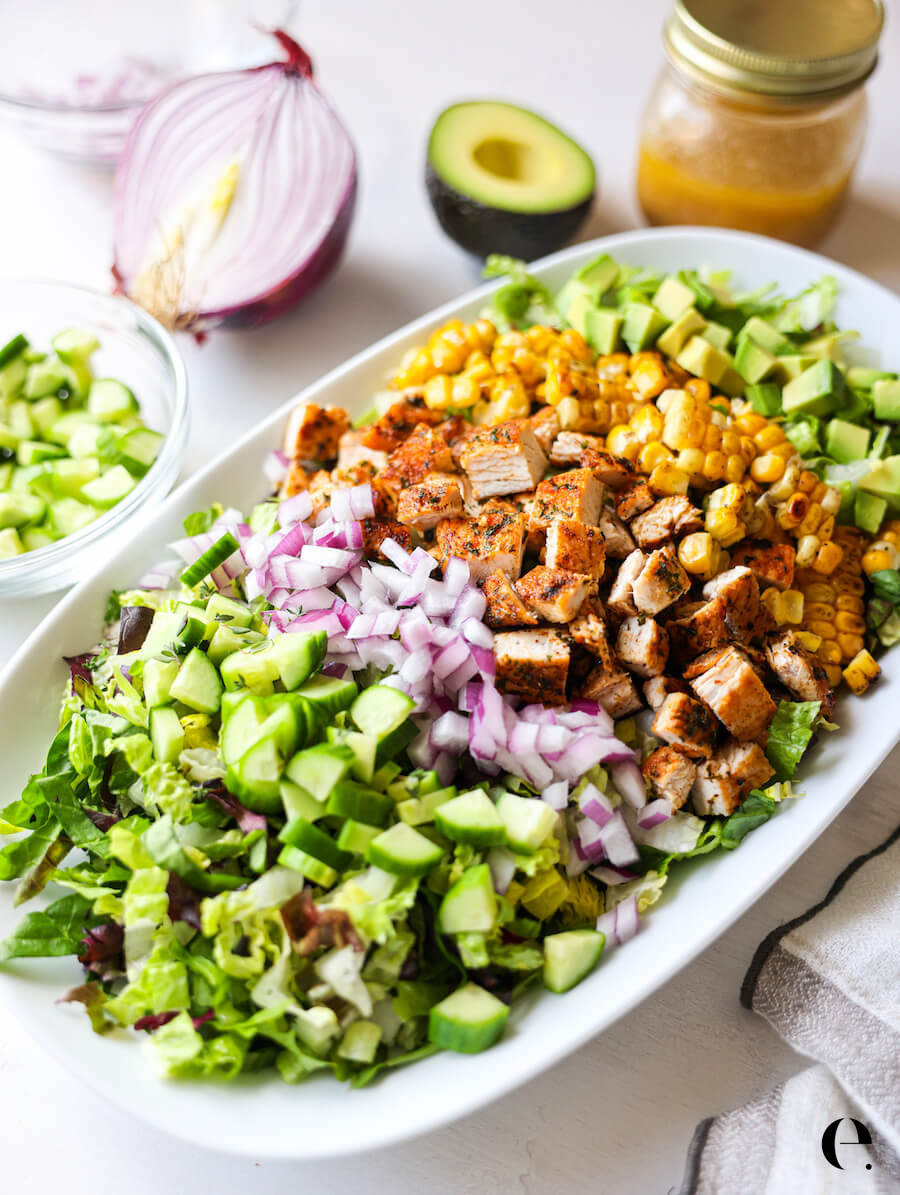


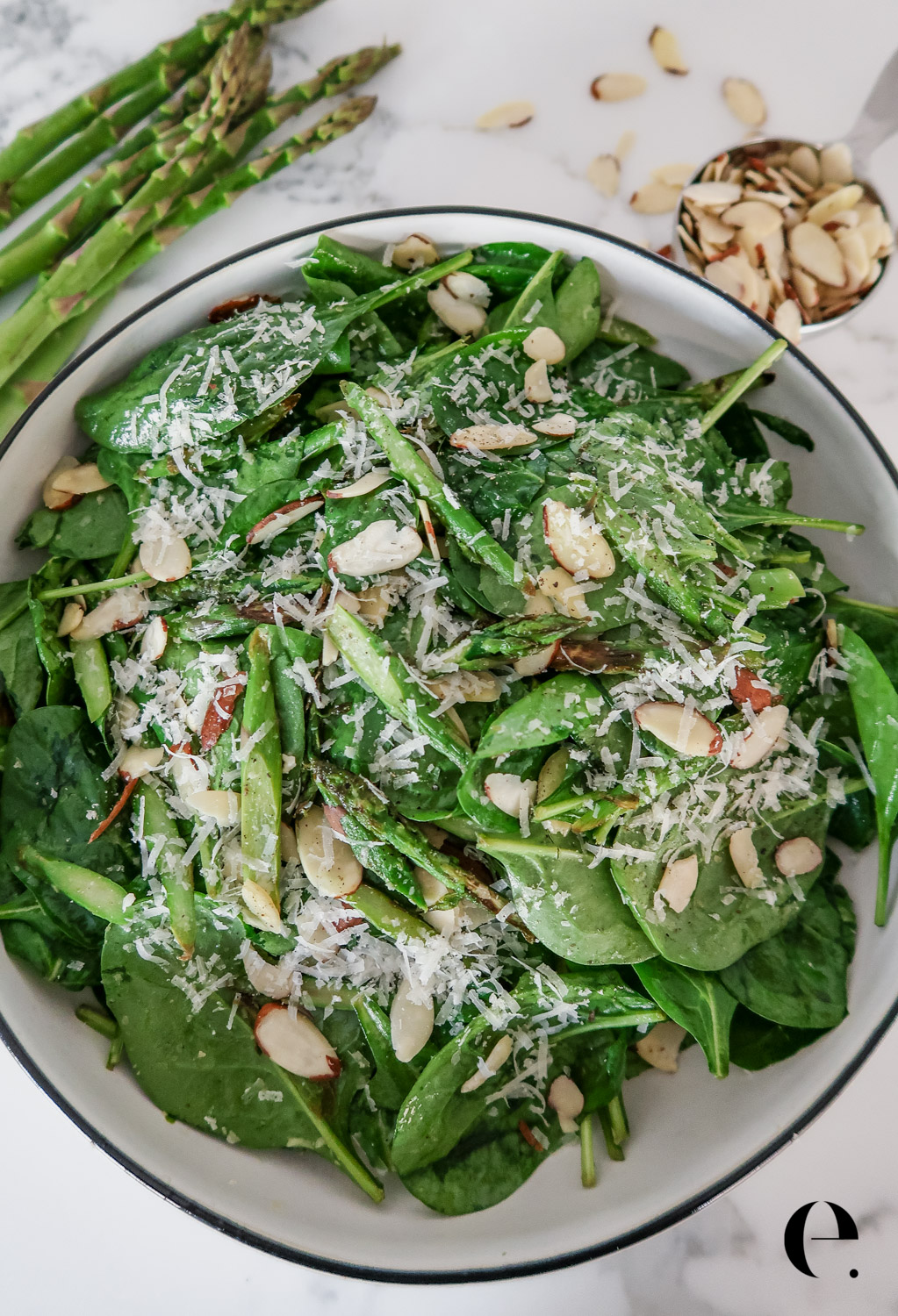

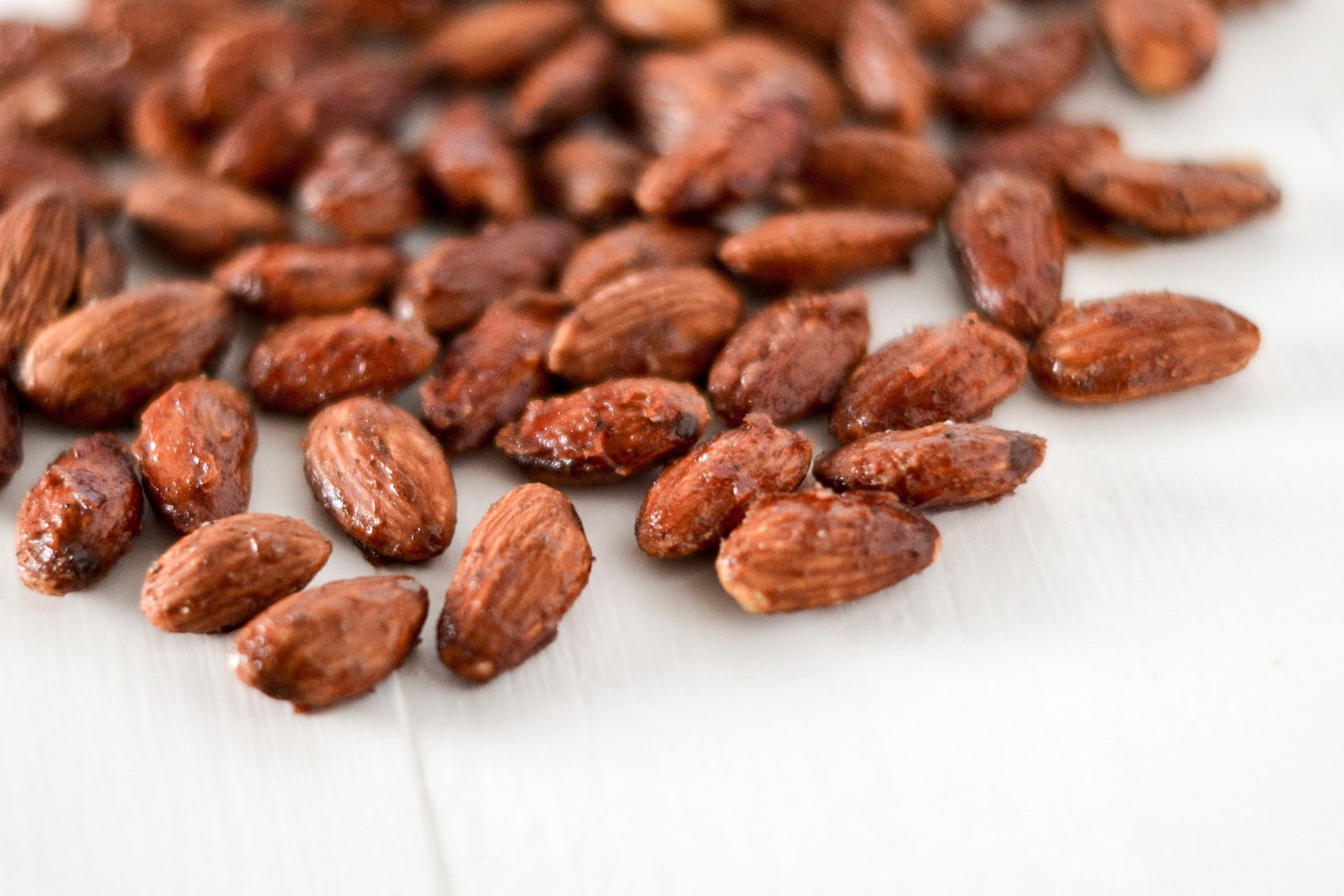
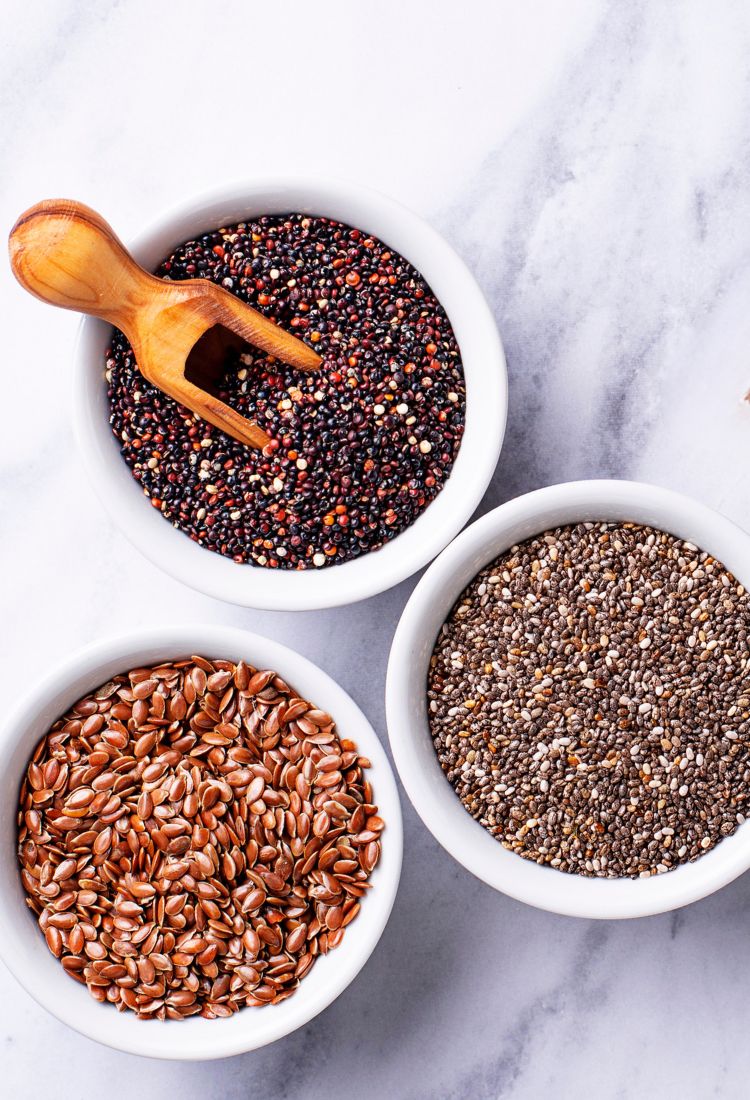


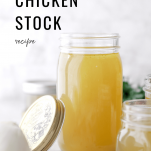
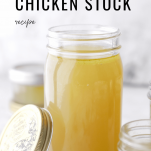

Why can’t you eat the chicken meat after??
You can eat the chicken meat. If I suggest removing it about 2 hours in so it’s not overcooked. If you cook the chicken meat longer than 2 hours, it will be rubbery, dry, and overcooked.
Making now since I had 3 organic carcasses in my freezer. I like to strain out some of the veggies, purée with some of the stock and use in the next chicken soup recipe I make. It takes the soup to the next level!
Glad you like it! ~E
so so so good. glad i found your site
Glad to hear it!
Sorry, I had not read through the recipe. I see the answer to my question. Thanks
I’ve used carrots, celery and onion for years when I boil chicken to make chicken salad. I even mash some of the cooked vegetables and add them to the Chicken salad. Plan to add the rest of your ingredients next time. How long does this chicken broth last in the refrigerator for later use?
Very nice. I’ve been playing with “the recipe” my mother “learned me” forty years ago, which she learned from her mother, and I finally got around to doing a “look-see” on the Internet.
Were I in need of a recipe, this would be a great start, and I hope I’d stick around to read your explanation as the making of a chicken stock is less a recipe and more an art.
I want to use this stock in a chicken pot pie, my question is the stock/broth is so gelatinous do I need to add flour when making the gravy for the pie? Wonderful recipe by the way.
Hi Alan, chicken stock/bone broth will only become gelatinous as it cools down, it will always be liquid when hot (science!). I think what you’re asking for is a gravy in your chicken pot pie, so yes, you’ll still need to make a roux/gravy for your chicken pot pie. I haven’t written a specific recipe for that, so use your favorite or find one on a recipe site. Enjoy! ~E
Hi there!love your recipe and have been doing it a few times. Just wondering if i use the instant pot pressure cooker, how long should i ;
pressure cook it for on high temperature? Thanks in advance 😊
How do you get a large amt of liquid when using a crockpot? Even a large one doesn’t compare to a stockpot?
A standard crockpot is 6 quarts. I get about 3-4 quarts out of my crockpot depending on the size of the chicken. Yes, a larger stockpot will have more room!
This is the first chicken stock that I made instead of bought and it is so good I never bothered with any other recipe. The difference in flavour with store bought stock (even the best ones) is amazing. Originally I followed the recipe exactly, but now, instead of using a whole chicken I cut the drumsticks, thighs and breasts off 2 smallish chickens and then use the carcases (which still have a lot of meat on them) for the stock.
Hi Tony, so glad to hear this. This is my all-time favorite, too, and SO much better than anything storebought. Love your idea for how you use the chicken. Thanks for stopping by to comment. ~E
Hello, thanks for posting this! 🙂
I have been trying to find some nutritional / calories information on chicken stock, and seem rather difficult to find based on what you get out of a whole chicken boiled, and then boiling the bones for a further couple hours.
If you had any details on that would be super helpful…
Thanks very much,
Tired of shop bought stock I decided to make my own, this is the first chicken stock recipe I tried but it’s so good and easy I won’t bother trying others. Just excellent.
Same to you
Is there any nutritional information available for this recipe?
I’ve made this several times now. I was intimidated by other broth recipes, and this one seemed more realistic. It’s 9 AM, I just strained my stock and had a big mug of it straight away. So delicious.
Hi there,
The recipe doesn’t mention anything about “ “ “skimming the scum“ During the initial boil. Is it necessary? Some chicken stock recipes highly recommend it while others never mention it.
What are the benefits (If any) from not skimming?
Hi Hannah, I generally find that you don’t have to with this recipe. If a lot of scum forms you can skim it off, but again I generally find that it doesn’t happen if you use the method above. I’ll add a note to the recipe notes about it. Thanks! ~E
Hi! This recipe looks great! I haven’t made chicken stock yet but so far this is the most helpful and straightforward post I’ve found. If I wanted to freeze some of the broth and chicken (separately) afterwards how would I do that? Just bring the chicken and broth to room temp and put them into freezer safe containers?
By far the best recipe I have been able to find after 2 hours of reading online! This is worth 5+ Stars!
Thanks Elizabeth for keeping it REAL.
Hi Bill, glad you like it! And I always keep it real. 🙂 ~E
Could I pressure can this recipe? Is there any reason I should not?
This was a most wonderful broth recipe! I took my time with this because I had six frozen bags of bones, fat, leftover meat to place in a much larger stock pot. I never added salt 🧂 for the summer. I felt there was enough residual salt from all the birds and juices from the saved roaster contents. Simmered for about seven hours. First straining was to get rid of all large bits and pieces. The second was where I for the first time in my life used cheesecloth with my fine mesh strainer. Golden broth! 😋 I tasted the broth in its gelatinous state, and I knew this recipe was a winner. Thanks 🙏🏻 for sharing the recipe! Best regards
even better is making bone broth in an instant pot (pressure cooker). Set on soup setting, then set time for 2 hours. Use slow release method which should add another 30-45 minutes. Tastes like 12-hour results on a stove in less than 1/3 the time!
Thank you for sharing your recipe! Will try it this week. But what can I do with the meat part after boiling? Am into Chinese dish. How long should I freeze these cooked meat for future cooking? Appreciate all guidance and advises. ☺️
Adding chicken feet makes a huge difference in the resulting broth… I can get them at Walmart, in 1ish pound packages…they are truly disgusting to look at, but the gelatin and the flavor they produce is amazing. I use 1ish lb chicken feet with a 5ish lb chicken and aromatics.
I added a whole lemon , and a red onion instead, added Parsnips and carrots chopped, and simmered about 3/4 hours, tasted the stock , and was the best i ever tasted..Mmmmmmm.
Removed the meat, left the bones and the vegetables, after about or less of 24 hours, tasted it,,,,,,YUK!!! threw it out.
Will try again, and stop after 4 hours.
Hi Mitchell, If you include a whole lemon (including the peel and rind) the broth will become very bitter. Never include a whole lemon for that reason. Instead, squeeze the fresh lemon juice in at the end. ~E
I recently made your chicken broth recipe and loved it. However, the corners of the quart-sized bags that I used for storage, broke while in the freezer. Is this normal? Perhaps I should have used half-gallon size bags. Where did I go wrong? Thanks.
Hi Suzanne, was it specifically a freezer bag? There is a difference between regular sandwich bags and freezer bags (the freezer bags are thicker and air-tight, while the sandwich bags are not.) Make sure the product you use is specifically meant for the freezer. Also, I’ve gotten away from freezing in plastic bags for environmental reasons, I think a freezer-safe glass storage container is better. Thanks for being here! ~E
I would not recommend using lemon with the rind from the beginning. The lemon oil will become bitter if you simmer it for more than 45 minutes or so. You should specify when to use the lemon.
Could you explain the use of vinegar and lemon slices?
Hi Joan, the acid in vinegar and lemon helps pull collagen out of the bones, which makes for a more nutritious broth. The amount is so small that you can’t taste them, but it helps make more use of the bones. ~E
I am making the chicken stock removed the plastic pouch with organs but did not take any notice of the paper pouch and left it boiling with the chicken for two hours is the stock still good to use.
Hi Elly, if it was paper it’s probably fine. If the plastic was left in I would toss it, but the paper is probably not a big deal. Happens to the best of us sometimes 🙂 ~E
I have never made chicken stock or broth before, but I plan to make this recipe today. I have a question: Sometimes I purchase the rotisserie chickens from the grocery store for a quick meal during the week. Can I use the carcass of the cooked rotisserie chickens in this stock recipe? If so, how long — how many days — could I safely save up the carcass before I need to cook it in a stock?
Hi Kim, this is a great question. I generally don’t use the rotisserie chickens for stock and they are coated with canola oil, and usually have very small bones. I’ve tried it before and it’s hard to get the stock to gel/solidify in the fridge. I think using a chicken you roast yourself, bones from chicken you roast yourself, or a whole chicken from the meat section is a better option. After roasting, use the carcass within a day for stock. Good luck! ~Elizabeth
Thanks for the recipe and the explanation about the bones and the vinegar. I love to make soup in the winter. I usually make a beef vegetable soup, but when simmering the stock (I use beef bones and beef shank), I leave the lid off the pot. This adds welcomed humidity to the dry closed up household and makes the place smell delicious. I just make sure to check the pot periodically to make sure there is sufficient water to keep the meat covered. After all, it’s just the water evaporating and not the flavors, right?. Also, after I’ve removed the meat and put the stock/broth thru a sieve/cheesecloth, I return the liquid to the pot, make sure it has a tight fitting lid (don’t want any critter interference), and place the pot outside overnight, sometimes even in a pile of snow. By morning, the fat has all risen to the top and can easily be removed. I only do this in the cold winter of course – cheap and fast refrigeration and I don’t forget the pot on the stove waiting for it to come to room temperature. Thoughts? Thanks again!
I’ve made this a few times now and it’s really good! I especially like the fact that I’m boiling a whole chicken and can save most of the meat.
I freeze 1-2 C shredded chicken in zip lock bags for future meals–soup, tacos, enchiladas, chicken salad etc. Much more moist and tasty from the broth.
I freeze the broth too:)
After making chicken stock with your wonderful recipe, I read further and realized that you directed everything towards women cooks. Should I discard the results of my efforts, or enjoy them with the hope your blog, etc. will become bisexual?
John, this is an absurd question. I adore men and often mention that everyone is welcome on my blog. I can’t be all things to all people, and the way I write my blogs is generally towards the largest demographic. About 95% of my online community is women but all are welcome here. I’ve never in any way said that men shouldn’t make my recipes, and certainly would never suggest that one would discard good food. And bisexual has a different meaning that what you insinuated here. All are always welcome here equally. ~Elizabeth
John, you’re pathetic .
Why do you use purified water in your chicken stock?
Hi there! In general I used purified water in everything because if you don’t filter it, then your liver has to. It just eases the burden on your digestive system, liver and kidneys. Boiling the water helps with some of that, but there are often pharmaceuticals and other things in tap water that boiling doesn’t take care of. From a culinary perspective, it can also help with the flavor of your dish because tap water can sometimes have a taste to it. Using purified water instead of tap water is optional but recommended. ~E
Thank you so much for this recipe!! I made this today for the first time, my whole house smelled divine and it’s taste is AMAZING! In love…..Thank you for sharing this great recipe.
Should I de-fat the broth?
Hi Susan, this is a great question. It’s really a personal preference. I usually leave it because there isn’t a lot when making chicken or turkey broth, and having some of the fat is good for you. If there is an excessive amount you can skim some of off (after it chills in the refrigerator it will float to the top). But if it’s a small amount, it will dissolve back into the stock when you heat it and it’s perfectly healthy. We need some fat in our diets, and when it’s from a natural source like this it’s perfectly healthy. Hope that helps! ~E
I’ve been making stock and broth for 35 years. For some reason, I don’t like carrots in mine. Celery, onion, bay, other seasonings/aromatics (except thyme, tarragon) are fine. Carrots add a sweetness I just don’t care for. Anyone else?
I made this with what I had on hand: a whole chicken, carrots, garlic, peppercorns, dried parsley, onion powder, bay leaves, and salt. I heater in the crockpot on high for several hours (I believe it took about 4 to boil), then low for 18 hours. It was perfect for my favorite chicken soup! Thank you!
On low for an additional 14 hours, that is.
Followed the instructions to a T. Simmered it for 6 1/2 hrs and tasted very bland. What could I have done wrong?
Cliff…add salt 1/2 ts at a time until the flavor pops! 🙂
This is my new go to chicken broth along with your recipe for chicken soup… so yummy! Love that it makes my whole house smell good and the chicken soup has helped ward off the crazy flu everyone is getting. Thank you Elizabeth!
Alex, so glad to hear it! I love this one too. Thanks for stopping by to comment. ~E
I make gumbo every New Years and have typically used store bought broth. This year, I decided to use homemade stock and found this recipe. So easy and delicious! I plan to try to make this every weekend – especially during this winter. Thanks!
That is great to hear! I bet it was delicious! Thanks for stopping by and commenting. ~E
It’s 2 am and I am starting my bone broth right now since i am feeling a cold coming on! Thanks for the recipe
Thank you for this simple and easy to follow recipe! You explained everything so nicely. I’ve read many recipes on making bone broth and yours makes it sound so easy! I’m making mine right now!
I try and make homemade stock, once a week, using all the scraps and bones that I save. Of coarse, with my whole family having bad colds the past two weeks, I have made more soup than I care to mention! 🙂
Anyway, I just wanted to add, I always like to add smoked turkey legs when making my stock. They are cheap, and add to the depth of flavor. I actually, have a stock pot simmering on the stove right now, and this time I’m adding in a couple of tablespoons of gelatin. 🙂
Can this be made in a crock pot or pressure cooker and do you have cooking times for those methods?
I always use a pressure cooker, faster and way tastier…